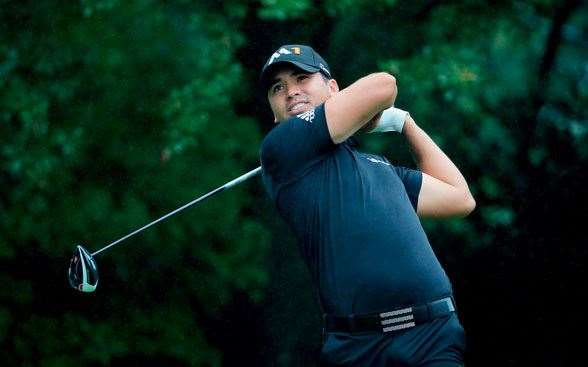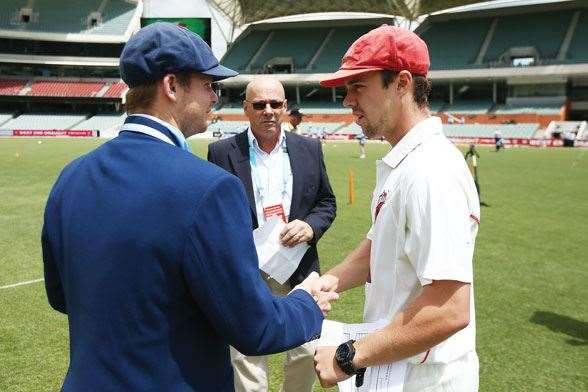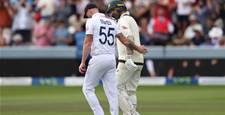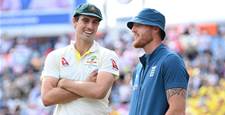If given the chance, it might just be able to find it.
The Australian Test team is crying out for new, young talent that can bat for the long haul. And, if given the chance, it might just be able to find them ...
 Joe Burns. (Photo by Getty Images)
Joe Burns. (Photo by Getty Images)An August night, not your usual cricketing hour. Unless, as it happened to be, an Ashes match was on in England, Nottingham’s Trent Bridge to be more precise. It was the fourth game of a series that had already shown itself to be capricious, mainly tied to the fortunes of Australia’s top order. When it performed to expectations, like it did in the Second Test at Lord’s where a Steve Smith double-ton led to a first-innings total of 566, the Aussies won the match. When it didn’t, induced to nervy collapse by the sideways-moving ball and dependent more than once on a tail-led bail-out, the English had claimed the other two contests in Cardiff and Edgbaston.
Before the opening session at Trent Bridge, the jitters mixed with the assurances. The Australians had made a mere 136 batting first in the previous Test. But surely they weren’t going to do that again. Surely the probabilities would tip back to more Lord’s-like proportions, and the Aussie bats would put up runs the way many thought they would coming into this tour. Surely, with English spearhead Jimmy Anderson out injured, things would be different.
They were; they would get worse. Historically worse. The primetime viewing audience in Australia watched in horror as the baggy greens’ entire first innings lasted about as long as an extended episode of bad reality TV, only with more contestants being dismissed. The Australian line-up faced 111 deliveries, or 18 and a half overs, which meant that no team had ever been bowled out faster in the 138 years that Test cricket has been played. Gags flew about people extolling the languid joys of the T20 format, or whether a side bowling first could enforce the follow-on. In that classic staple of under-nines cricket, the top scorer out of the total of 60 was “Sundries”, with 14 runs.
There was plenty of cricket left to play, but the Ashes had been lost for good in those 90 minutes. The shock of such a face-plant at a decisive moment made this nadir deeper than the other notorious Australian batting collapse of recent vintage, the all-out for 47 against South Africa in Cape Town in 2011. But that looked like an aberration in an altogether freaky Test, particularly as it came on top of the Proteas getting out for 96 ... By contrast, Trent Bridge was the culmination of a problem that had been compounding for a while. Losing competitively? Fine. But humiliation? Never. Channelling the political focus of the government at the time, one Twitter wiseacre said the foreign minister was moving to revoke the citizenship of Australia’s top-order batsmen. Some might not have thought it a joke.
******
On another continent, actually a subcontinent, another Australian team was playing. Australia A tours exist in this weird netherworld in which nobody outside of the nuffy circles pays much attention. And yet, there is some serious cricket being played for real stakes. “Those games that we played, they’re all first-class games,” says Cameron Bancroft, an opener from Western Australia. “And you’re playing against some players who have played international cricket. And I wasn’t one of those guys; it was my first tour with an A team.”
Victorian batsman-wicketkeeper Peter Handscomb had previously visited India and Sri Lanka on academy tours. “So I’d had a little bit of practice in the subcontinent, but it wasn’t exactly against blokes like Ohja or Mishra,” he says. “Despite not getting any media attention, and the outside world not hearing about the game, the selectors are watching; we still know there’s pressure on us to make runs and take wickets.”
Eight days before the Nottingham Nothing, the Usman Khawaja-led Aussie A team had taken on India A in their second four-day match in Chennai, and came away with a rarity for any Australian side – a series win in India. Bancroft had been the standout, making 150 over six hours in the first innings, and was at the crease for the winning runs in the morning of the last
day. His steadiness out in the middle earned acclaim from perhaps the most astute judge of it, India A coach and legendary tough-out Rahul Dravid, who was particularly impressed with Bancroft’s concentration against the spinners.
The A side began a series of one-dayers against South Africa and India after the unofficial Tests, and as their compatriots were death-marching back into the field at Trent Bridge, the Aussies met their hosts in their second 50-over match. Joe Burns had joined Khawaja in the ODI opening partnership, and had made an unbeaten half-century in the previous game. That wasn’t nearly enough for him – the Queenslander plundered 154 off 131 balls, including 14 sixes, one short of Shane Watson’s Australian record in an ODI. While it may have looked on paper like a typically modern, big-bang innings, the interesting quality of it was how measured it was, a point not lost on the ESPN Cricinfo correspondent at the match, whose main impression of Burns was how “stable and sensible” his batting was.
Burns echoed his team-mates’ opinion of the type-A experience. “To beat India in the four-dayers, then make it all the way to the [ODI] final and lose our only game, it was a great achievement,” he says. “The most important part of it for me was we were training so much in India – four weeks where we were training every day in those conditions; it just makes it easier if you return back there.”
******
With another away Ashes series lost, this one coming after reasonable expectations of finally ending a winless streak in England that now exceeds a decade, there was bound to be some call for renewal in the Test XI. Factor in the retirement of several veterans who had looked to the Ashes as their finish line, and this period was primed for transition. But the extent of Australia’s batting travails had observers calling for radical action. In these circumstances, there’s an impulse to bypass names made semi-familiar after repeated summers of piling up Sheffield Shield runs, and instead reach down for the player with potential.
It’s the privilege of a nation with deep cricketing resources to instinctively believe that there is always some young batsman out there who will cut it at the highest level, once given a spot. These new names get slung about, often via the backing of their state-based constituencies. There’s Bancroft from the west, Burns from Queensland. Nic Maddinson is a dasher who his NSW team-mates say has matured recently as a batsman. Jordan Silk is Maddinson’s team-mate for the Sydney Sixers in the BBL, but shows his wares as a future Test player for Tasmania. Travis Head, at 21, is already the captain of South Australia. Handscomb, along with Victorian colleague Marcus Stoinis, will seek to reverse their state’s odd underrepresentation in the nation’s Test batting ranks.
All are under the age of 26. Finding a true Test player among the bunch would be resolving a spot in the national side long-term, which is an enticing thought. The Test team’s upturn since the arrival of Darren Lehmann in mid-2013 has been a revival, but it was hardly a rejuvenation – it depended heavily upon veterans such as Brad Haddin and Chris Rogers. Only Steve Smith, who also happens to be 26, represented generational turnover.
It hadn’t been for lack of trying. In his new book Winning Edge, Mike Hussey noted that there had been a push for younger players in the side around 2010-11, but picking them over established first-class cricketers had led to a soft culture developing within the team. “At lower levels, it’s fine to blood a youngster or two,” Hussey says. “But you’re playing for Australia. It’s only 11 spots in the whole of the country. You’ve got to really earn that spot and deserve that spot. That helps bring out a good culture, one in which players never take it for granted.”
Hussey understands being made to wait. He was 30 years old when he made his Test debut, then famously went on a tear to start his international career: eight centuries in his first 20 matches, with an average hovering around 85. He is the poster boy for every hardened Shield pro just waiting for a shot. “From a batting point of view, it takes a bit of time to figure out the game; how to bat, how to score runs, and how you play best. Quite often, you don’t work that out until your mid-to-late 20s at least,” he says.
“If they’ve come into the team a bit later, they’ve probably got a better chance of performing on a more consistent basis. If you’re picking someone younger on potential, they’re probably still working out how they play the game. There will be exceptions to the rule, but there’s probably less chance that they’re going to be a consistent player for a long period of time.”
Hussey had just been doing television commentary of the Matador Cup, so had seen many of the hotshot batsmen making the rounds in the domestic one-day comp. He had watched Head make 202 for South Australia against WA, the fastest List A double-century on record, and pointed out that a score like that in any format was a good effort. Perhaps even more impressive was that Head made it while chasing, and Bancroft had made 176 himself to set a target of 351. Hussey noted the buzz around Bancroft: “Whether he gets the opportunity, I don’t know, but he certainly looks technically and temperamentally a very fine player. He’s one that stands out.”
While the man known as Mr Cricket has his suspicions about the influence of T20 on the culture of cricket, particularly its team-oriented aspects, Hussey doesn’t buy the theory that it has eroded the capability of young batsmen to excel in longer forms. “There’s probably half a dozen to a dozen more,” he replies, when asked who might have caught his eye. “I don’t like to name individuals; I don’t want to put any more pressure on any particular player. But there’s certainly the talent out there for the next generation of the Australian Test team to have a lot of success. The system we’ve got in place, the levels and layers you come up through the ranks, it’s very sound and strong. That’s why the process is good for young players to come through.”
 Cameron Bancroft is in no rush at the crease. (Photo by Getty Images)
Cameron Bancroft is in no rush at the crease. (Photo by Getty Images)Cameron Bancroft doesn’t think of himself as a patient person, and cops to being a little intense. “I wouldn’t say I’m very patient outside of cricket,” he says. “I know my team-mates describe me as being really intense, and if anything, doing too much. Am I chilling out enough?”
The 23-year-old has had to work at relaxing. He does the Sudoku puzzle in the paper every morning, and gets out to play golf and body-board. He’s taken to heart his sessions with Cricket Australia psychologist Michael Lloyd about mindfulness. “Out there in the middle, you need to have routines – not necessarily superstitions – to be able to clear your mind, so when you walk up, tap your bat and look up, you’re as clear as possible to make the best decision for whatever is being bowled,” he says.
“I like to walk to square leg, walk out of the way. There’s lots of things I’ve learned through mindfulness. It’s not everyone’s cup of tea, but for me, it’s been extremely useful.”
The curious thing about all this is Bancroft has built his burgeoning reputation upon a classic Test batsman’s approach. He’ll take his time, get his eye in, occupy the crease. His major cricketing influences – father Frank, batting coach Wayne Andrews, WA state supremo Justin Langer – all instilled this patient mindset. As long as he stays out there, starts turn into big scores.
During last year’s Shield season, Bancroft played the innings that marked him out as the antidote to these kids and their newfangled batting ways. WA had a berth in the final on the line, and NSW had put on 407 in batting first at the WACA. In response, Bancroft batted for nearly 800 minutes, making 211 and sealing a draw that guaranteed WA’s advance.
Bancroft ended up as the third-leading run-scorer in the 2014-15 Shield, somewhat overshadowed by his state captain Adam Voges, who scored the fourth-most runs in a Shield season. It was validation for Bancroft after a somewhat poor season the previous year. He credits Langer, the former Test opener and likely future national coach, for challenging him.
“JL doesn’t accept anything but 100- percent dedication and excellence to whatever task you’re doing,” he says. “You can’t slacken off, can’t give half-hearted efforts. Every time you go out in the middle is a chance to score big hundreds.
“As a batter, that’s your job. I remember in my first season of Shield cricket, JL asked me how many runs I’d targeted to score that season. I pulled out a figure of 500 – to be brutally honest, I was happy to get a game at that stage.
“He said, ‘That’s not good enough.’ You don’t strive for mediocrity, you shoot for the stars and beyond. That’s something I’ve had to learn. You can’t play for Western Australia and just expect to play – you’ve got to contribute, do your job and love doing it. And that’s the biggest thing I’ve learned from JL, that ability to be hungry.”
Bancroft’s domestic showing put him on the path to his success on the A tour, and indeed, the selectors were watching. His aptitude for handling subcontinental spin earned him a spot on the squad to tour Bangladesh, with a Test debut in the offing as both opener spots were vacant (Rogers retired, Dave Warner resting). National selector Rod Marsh noted of Bancroft that “his whole demeanour was that of a player who is determined to play Test cricket”.
Bancroft, understandably, was thrilled. “I remember our lady who looks after our player business at the WACA rang me and said ‘all your gear’s arrived’. It was really exciting to get my training gear, playing top, cricket bag. I was like a kid at Christmas, loving life.”
Alas, Bancroft’s patience would be tested. His Test debut would be delayed as the Bangladesh tour was cancelled because of security concerns. Trying to make the best out of a bad break, Bancroft noted that he would get to play in the Matador Cup in place of going to Bangladesh. He hadn’t played much one-day cricket for WA, and it was something that would be beneficial for him – a chance to convince people that he’d improved the stroke-playing side of his batting; that he could score as well as survive in the middle.
“At the end of the day, Cricket Australia made the right decision,” he says. “Looking after player welfare is the most important thing. Not literally speaking, I would have taken a bullet to get an opportunity to wear a baggy green cap. But that’s the way it went, and it was the right way to go.”
******
Joe Burns is back in his baggy green: Test cap number 441. He first got it in the home series against India last year, an experience which he describes as akin to a last-minute vacation deal. He was with his T20 team, the Brisbane Heat, in Sydney for a Big Bash League game. “I got the call that morning that I’d been picked for the Boxing Day Test,” he says. “It was actually a really good experience, because I had the chance to immediately be with my team-mates with the Heat and celebrate that moment with them. It took off from there: media that day, play that night, fly to Melbourne that next morning.
“I went to Melbourne with one change of clothes. I was only planning on being away for one day. I left for a T20 game, and then returned home a month later after playing the Boxing Day and New Year’s Test. I was very trendy for the next few weeks. I had bought all my clothes in Melbourne.”
Burns received the new-guy treatment – don’t sit there, so forth. But his transition in the Australian dressing room was made smoother by Lehmann’s presence, who had previously coached Burns in Queensland. “My first two years as a professional cricketer, I had Boof as my coach,” he says. “He taught me how to play the game at a professional level, how to go about it. It gave me a lot of confidence to know you’re coming into a setup which I’ve based my game around.
“To have those familiar faces ... the stakes are higher when you’re playing for Australia, but it felt like just another game. Easier said than done, but it’s a hell of a lot easier when you have those familiar support staff around.”
Burns’ ascent in the game was methodical, going through almost every level of Brisbane’s Northern Districts club before debuting for his state in 2011. He believes the gradual steps made him into the batsman he’s become. “You learn how to do the hard work for yourself, to some extent. When you’re in the accelerated programs that there are now, at times, a lot of what you need is provided for you. As opposed to learning what you need for yourself, and what works and doesn’t.”
This process also developed Burns’ standout attribute – he has great versatility as a batsman, having made his name as an opener in Shield, but he's also perfectly comfortable in the middle order. Lehmann said it was a reason why Burns was picked during last year’s series, and as spots in the order are in continual flux with the changes in personnel, Burns’ capability to slot anywhere could prove very useful.
Opening against NZ is just fine.Rogers, for one, endorsed Burns as his replacement at opener. Burns isn’t fazed about where he bats – couldn’t even force himself to express a preference. As he sees it, as long as he gets an extended run in a particular spot, he’ll be able to prepare for it. It’s not unlike the way batsmen have to adjust to the various formats of cricket these days.
“You start to learn the way you train, you maintain a consistency, and when you get out to the middle it’s more a tempo thing in your mind,” he says. “When I was younger, I chopped and changed the way I train. Now that I’ve done it a few times now, changing formats, I find if I maintain the same training principles, that allows me to hit the ball well. When I get into the game, the game is dictating the way I’m going to bat. I make sure I tick off everything I need to bat well, and then when I get into the game, it’s a different beast.”
Being prepared is within his control; selection had been another matter. After a pair of half-centuries in the Sydney Test, Burns was dropped for the West Indies and England. He was philosophical about it: “I took confidence from the Sydney Test that I was able to perform reasonably well and trust I’ve got the game to hopefully get back there. I guess it’s probably the best way to be dropped – when you’ve done pretty well, because you know you have the game to get back. You don’t have to go away and change anything.”
Burns did one big thing in the aftermath of his Test debut, completing a university degree that dated back to before his start in state-level cricket. He began his studies so he’d have something if cricket didn’t work out, and Burns is adamant that he couldn’t have been one of those players with nothing to fall back on. His degree is in economics, with an eye to a future job with a bank. For lovers of cricketing novelty, it would be neat if Burns ends up in an opening partnership at some point with Ed Cowan, if only to have a pairing that could swap mid-pitch conversations about market corrections.
According to Burns, the last four subjects took him three years to finish, as the business of scoring runs got in the way. “I finished my final exam after the Sydney Test. I was meant to do it on about the 20th of December. I had to defer the exam because I was picked in those Aussie teams.
“I had to talk to a few different people at QUT, until I finally spoke to one person that realised it wasn’t manageable to move the Test match, or not attend the Test match ... I said to them that I may have to miss the exam, because I don’t think the Boxing Day Test could be moved.”
 South Australia captain Travis Head meets THE captain, Steve Smith. (Photo by Getty Images)
South Australia captain Travis Head meets THE captain, Steve Smith. (Photo by Getty Images)The lot of a batsman on the verge is highly unforgiving. One random delivery early on and you’ve “failed”; if it happens again, it’s no longer random. If you make a fine 90-odd, people ask questions that they wouldn’t if you managed to creep across 100. “The thing is, especially as a batsman, you can make one wrong decision, play one false shot, and that’s your innings,”
says Peter Handscomb. “And that might be your only innings, so you don’t get to showcase what you can do. But on the flipside, you can get dropped early on and then you can go on to make a hundred, and everyone forgets you were dropped.”
That was what happened on the A tour to the 24-year-old: a 91, then duck-duck. “That was it; three hits, and I didn’t get many opportunities in the one-dayers, either. Looking back on it, I wish I’d taken my opportunity a bit more. I was on 91 and hitting ’em well.”
Handscomb is another among the ranks of young batsmen still seeking a breakout moment. Shane Warne is a fan, bringing his name up as a possibility in the post-Ashes chatter. He was called in as cover for the Australian ODI squad in England, largely due to the fact he was around playing for county club Gloucestershire (both his parents are British, who met in Australia). But he’s another player whose game appears suited to Tests.
Handscomb was a talented junior tennis player, and ran around those circles the same time Bernard Tomic did. He loved the game, but says cricket chose him – chasing the tennis tour would have required far more resources. There was another factor: he was a smaller kid, a serve-volleyer who didn’t have the baseline physicality that sport requires these days.
It came to inform his batting as well. “Trying to hit sixes and fours just wasn’t my game,” he says. “I had to learn how to hit it through the field or manipulate it for singles. I had that passion since I was a kid for moving the ball around rather than the crash and bash. Even now, I still struggle to clear the rope every now and then.”
If Australian cricket ever does strain for first-class batsmen, the slight youths might be where they should go looking – Bancroft had the same explanation for where his temperament came from. Handscomb is also a wicketkeeper, something that he doesn’t need to do much for the Victorian Shield side with Matthew Wade around, but will pick up the gloves for the Melbourne Stars in the BBL. “It was a way to get me a game, but in the last couple of years I’ve tried to earn my right to play as a batter,” he says. “I kept two games in the Sheffield Shield last year while Wadey was away playing for Australia, and I made 90 in one game and 100 in the other, so it didn’t affect me too much in those games.
“I think at Test level, it is definitely different, and it has shown that when those players dropped the gloves, their batting went through the roof."
Like so many others, Handscomb will try to give the selectors reasons to pick him, and then bide his time. In a fluid situation with the nation’s XI, who knows what can happen? There have been times when an outsider couldn’t crack the Australian batting order with a crowbar, and the list of batsmen who never made it was exquisite. This is not one of those times, and the right kind of chance could mean the difference between a Test appearance and a Test career. And there’s a bunch of young guys who can’t wait to show how patiently they can play.
Related Articles

Luck of the Draw

Harman hails lookalike Ponting as 'handsome fella'













